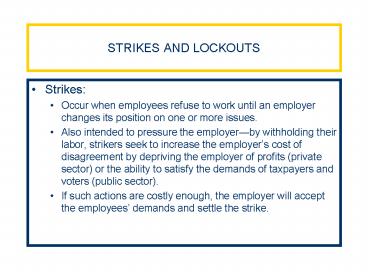STRIKES AND LOCKOUTS - PowerPoint PPT Presentation
1 / 13
Title:
STRIKES AND LOCKOUTS
Description:
... initiated rather than worker initiated work stoppage during a bargaining impasse. ... party investigates a bargaining impasse and issues non-binding ... – PowerPoint PPT presentation
Number of Views:5351
Avg rating:3.0/5.0
Title: STRIKES AND LOCKOUTS
1
STRIKES AND LOCKOUTS
- Strikes
- Occur when employees refuse to work until an
employer changes its position on one or more
issues. - Also intended to pressure the employerby
withholding their labor, strikers seek to
increase the employers cost of disagreement by
depriving the employer of profits (private
sector) or the ability to satisfy the demands of
taxpayers and voters (public sector). - If such actions are costly enough, the employer
will accept the employees demands and settle the
strike.
2
STRIKES AND LOCKOUTS
- When employees strike to win better wages,
benefits, and work rules the strike is considered
an economic strike. - Economic strikes are the most common frequent of
strike in U.S. labor relations. - Closely related to an economic strike is a
lockoutan employer initiated rather than worker
initiated work stoppage during a bargaining
impasse. - It is important to differentiate between types of
strikes because U.S. legal doctrine in the
private sector is different for each one.
3
TYPES OF STRIKES
4
PICKET LINES
- Workers, their leaders, and their supporters
march outside the struck employers location(s)
to publicize their dispute, convince the public
not to patronize the business and workers not to
cross the picket line, create solidarity among
the strikers, and otherwise build support for
their cause. - In economic and unfair labor practice strikes,
picketing is legal but is not without legal
limitations. - Picketing raises several important issuessuch as
what about employees who want to work instead of
strike and therefore cross their own unions
picket line.
5
PUBLIC SECTOR STRIKES
- All types of strikes are more likely to be
illegal when conducted by government employees. - Prohibiting public sector strikes is rooted in
several traditional beliefs - That striking against the government is an
unacceptable threat to the supreme authority of
the government - That public sector employee bargaining power is
too high because there are no market-based checks
on their demands - That government services are too critical to be
interrupted. - Strikes by federal government workers are
prohibited and only 25 of states grant even a
limited right to strike.
6
NATIONAL EMERGENCY STRIKES
- Like in the public sector, there is a concern in
the private sector law with strikes that
seriously harm the public interest. - Because of the critical importance of railroads
in the early 20th century economy, the Railway
Labor Act empowers the president of the United
States to create a Presidential Emergency Board
if a strike would threaten substantially to
interrupt interstate commerce.
7
MAJOR U.S. STRIKES, 1950-2002
8
STRIKE REPLACEMENTS
- Employees used or hired to do the work of
individuals on strike are called strike
replacements or replacement workers (or in the
most derogatory language, scabs). - Strikers that have been replaced permanently
replaced are not necessarily entitled to
immediate reinstatement back to their old jobs
once they end their strike. - A 1938 Supreme Court ruling (NLRB v. Mackay Radio
and Telegraph Co.) established that absent
discrimination based on union activity, both
temporary and permanent strike replacements are
legal. - Is the strike threat viable anymore?
9
BOYCOTTS
- A boycott is a campaign to encourage a companys
customers to stop doing business with it. - In a bargaining dispute in the U.S. private
sector, a boycott is generally legal if it
narrowly targets the company directly involved in
the dispute. - Section 8(b)(4) of the NLRA prohibits secondary
boycottsboycotts that target secondary rather
than primary employers.
10
WORK SLOWDOWNS
- Slowdowns try to pressure employers by imposing
cost through lowered productivity, but without
employees leaving their jobs. - The most creative type of slowdown is a
work-to-rule campaign - Refusing to work overtime is a partial strike.
- A series of repeated quickie strikes amounts to
an intermittent strike. - The basic goal of these job actions is to disrupt
the employers operations, and at the same time
make it difficult for employers to hire
replacements.
11
THIRD-PARTY DISPUTE RESOLUTION
- Third-party dispute resolution mechanisms use a
neutral third party to settle bargaining impasses
with the goal of avoiding costly strikes. - In the private sector, property rights and the
freedom to enter into contracts means that
third-party dispute resolution is generally
voluntary. - In the public sector, the primacy of serving the
public interest means that third-party dispute
resolution is often compulsory. - Third-party dispute resolution mechanisms are
- Mediation
- Arbitration
- Fact-finding
12
INTEREST ARBITRATON
- Interest arbitration is designed to resolve
interest disputes that result in new contractual
terms that govern wages and terms and conditions
of employment. - Two primary forms of interest arbitration
- Conventional arbitration
- Final offer arbitration
- total package
- issue-by-issue
- As with mediation, interest arbitration is
voluntary in the private sector and often
mandatory in the public sector. - Most interest arbitration takes place in the
public sectormore than 20 states have some form
of compulsory arbitration statute.
13
FACT-FINDING
- A third party dispute resolution method in which
a neutral third party investigates a bargaining
impasse and issues non-binding recommendations
for a settlement. - Is essentially non-binding arbitration.
- Typically, hearings are held where each side
presents its case, which is then followed by a
report containing specific terms of a settlement.
- Unlike arbitration, fact-finding does not
guarantee a resolution. - Unlike mediation, fact-finding does little to
help the negotiating process in order to
facilitate productive bargaining and a
settlement. - In fact, fact-finding appears to increase labor
conflict relative to public sector jurisdictions
that settle disputes with strikes or arbitration.































